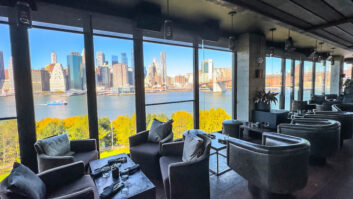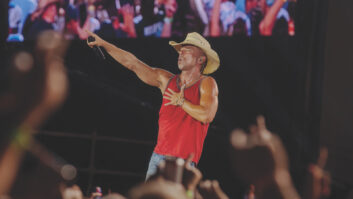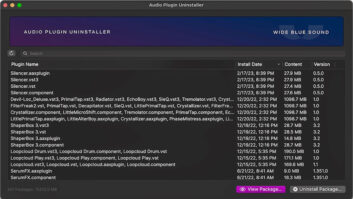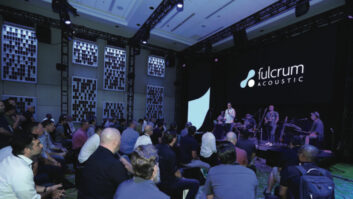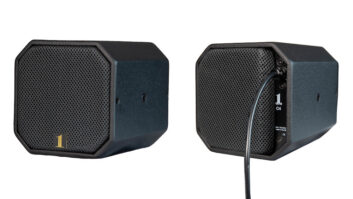In the hype-filled world of the music industry, where words like “legend” and “masterpiece” have been cheapened by overuse, Tom Dowd truly is a legendary figure who has presided over many acknowledged masterpieces. He has worked his magic for six decades now, and few would be foolish enough to bet against him opening a seventh decade with yet another great, memorable project.
During his student days at Columbia University in the 1940s, Dowd pursued two very different areas of interest: As a physicist with a strong background in electronics, he worked on the infamous Manhattan Project, which developed the atom bomb; as a musician, he played in the school’s band and orchestra. Fortunately for all of us, his love of music won out, and by the end of the ’40s he’d found a career that combined music and technology-he became a freelance recording engineer. Originally working direct-to-disc, he helped introduce Atlantic Records to stereo recording in 1952; two years later he joined the company as a staff engineer and equipment designer. He designed Atlantic’s 8-track studio on West 60th Street in 1959 and started recording there in 1960. These were glorious days for Atlantic Records. Often working with Ahmet and Nesuhi Ertegun and Jerry Wexler, Dowd tracked many of the most exciting pop and jazz artists of the day. On the pop side, The Drifters, The Coasters and Bobby Darin were just a few of the greats Dowd captured at Atlantic’s studios. He cut classic sides with the incomparable Ray Charles that are still considered among the most soulful records ever made, and his work with jazz giants such as Charles Mingus and John Coltrane produced a number of landmark recordings, including Mingus’ “Mingus’ Mood” and Coltrane’s “My Favorite Things” (see this issue’s “Classic Tracks” on page 164.).
In the late ’60s, working in New York, Muscle Shoals and wherever the music took him, Dowd continued to show his versatility, cutting with the late, great Otis Redding, Ben E. King and an up-and-coming soul and gospel belter named Aretha Franklin-Dowd recorded most of her Atlantic hits. Dowd also was behind the board for one of the most famous psychedelic albums of the ’60s: Cream’s groundbreaking Disraeli Gears.
By the late ’60s, Dowd had moved from engineering into production, where his golden ears, his tremendous sense of organization, his affable nature and even temperament made him ideal for the job. Besides his production work with Aretha, Dowd worked on The Young Rascals’ biggest hits, helmed three of The Allman Brothers’ classic early ’70s albums (including their incendiary Fillmore East set) and was behind the board at Criteria Studios for Derek & The Dominoes’ epic Layla album. Following that, he produced a string of hit solo albums for Eric Clapton, including 461 Ocean Boulevard, which included the Number One smash “I Shot the Sheriff.” Among the other artists Dowd produced in this era were Dr. John, Delaney & Bonnie, Buddy Guy & Junior Wells, Lynyrd Skynyrd and Rod Stewart, with whom he worked on five albums.
It’s a credit to Dowd that so many of the artists he recorded and produced through the years kept asking to work with him again and again. His partnership with Clapton stretched into the ’80s; and his close relationship with The Allman Brothers went well into the ’90s, encompassing several more fine albums. For Dowd, a life in music has always been about people first and foremost, and about capturing those flashes of musical magic that transform our lives and move our souls.
In this first installment of a two-part interview, we trace the 1999 TEC Awards Hall of Fame inductee’s early career, from the late ’40s through the mid-’60s.
How did your work in physics and on the Manhattan Project put you in good stead when you finally got into recording in the late ’40s?
Having worked with such sophisticated electronic equipment, and being musically sensitive, recording was child’s play. We were still in the Stone Age when it came to recording. I had no problem whatsoever just looking at the equipment that existed and adapting to it in like a week’s time, because we were still cutting direct to disc, and that was primitive.
What kind of music were you working on at the beginning-big band?
In 1947 it was called predominantly “race,” and it was either race or jazz.
Were you a jazz fan?
Yes. I [worked] with Dizzy Gillespie, Charlie Parker, Lester Young, Lennie Tristano, George Shearing, Max Roach, those people. That was 1947. There was a major strike in 1948 by the musicians. Put a big hole in things for a while. But that helped us. Then, by the end of ’48, beginning of ’49, they introduced tape machines to the studio, and that was another world. Then there was a new generation of engineers that could make wonderful tapes but couldn’t put the damn tape on a record, [laughs] because of the parameters of forgiveness on the tape that don’t exist when you transfer to disc.
Was there anything in your personality that you had to adjust to get used to working with musicians? Working with Dizzy Gillespie and working with Charlie Parker are probably two different things.
No. I’d listen to records. I used to do all kinds of things for fun. If I had the opportunity, I’d go down 52nd Street, I’d go down to the Village, I’d go up to the Apollo and watch the amateur hour. And all of a sudden I’m recording them, saying, “Hey, that’s the guy who plays in so-and-so’s band.” Or, “I know who that is!” I was making contact with these people, one on one, for the first time.
And how did they strike you as a breed?
Boy, they were wild! [Laughs.]
You didn’t really have a military head, as they say, did you?
Oh, no. Not at all. And the musicians knew nothing of my background.
The less said the better, probably.
Yeah. Probably all they knew was, “Oh, the kid knows what he’s doing. Hey, man, he put a microphone on the bass? He’s crazy!”
Had that not been done?
See, we were using hand-me-down radio equipment. And I’d sit there and listen to a quintet or something like that, and I’d say, “Man, I need a mic by the piano-he’s got a solo.” And I’ll put this mic up for the horns. And ask them to step in and out when they’re going to solo. I got a bass player and a guitarist and a guitar-put a mic between the two of them and then adjust their dynamic. And all of a sudden, when we played back the first acetate, they’re looking at each other and saying, “Hey man, that’s cool.” I got along famously with them. There was little or no dialog that was like, “Man, what the hell are you doing?” It was, “Hey, man, can you do this?” Or, “What’s this you’re doing?” And I’d say, “Well, I’m trying to do this or that.” And they’d say, “Okay, fine.”
Were you aware of the accepted models of the day? Columbia had a certain way of recording. Rudy Van Gelder wasn’t really happening then yet, right?
No. There were several things that I finally became more sensitive to. Columbia and RCA were radio stations. And the people who were doing all the recording were generally the engineers who they would send out on the nighttime gigs, for the dance bands at so-and-so. So when it came to recording, those were the guys. And what do they do? They put up one microphone for the band and one microphone for the vocal. “All right, this is it.”
Hope for the best.
And of course, don’t let the meter go into the red. Well, by now I’m thinking there’s no high sound that goes into the red that’s going to hurt the record. The only things I have to worry about are the low frequencies. So I’m taking advantage of what more I can get on the record that you’re not accustomed to hearing by using more than one mic.
And what are the prevalent mics of the day? This is pre-Neumann, obviously, right?
No, we didn’t have Neumann. We had [RCA] 44s, 77s, 639As; Western Electric 639s. Salt shakers. Turners. That was about the best variety you could have.
Studios were mostly abandoned radio-station rooms or something. [Laughs.]
With that lovely acoustic tile.
When I started working for Atlantic, I thought of all the different rooms I’d been in New York over the years, and I thought, “Man, that room sounds good, but that wall sucks.” So all of a sudden, I’m adjusting my thinking. If I have an opportunity, I don’t want to do this and that. Some things I love, and there are other things I hate, and there are some things that I realized I can just use a pinch of, not a teaspoonful.
When you started working for Atlantic, did you know at the time that you’d be helping them build a studio?
No. It was evolution. As Atlantic became more and more successful, some of the productions called for more space. The staff was no longer three or four people; it was like maybe ten or 11, and they were sitting on top of each other. Heretofore, it had been that the accountant would come by once a week and look at the books. It was a mom-and-pop operation. We used the office in the front of the building as the studio. As it got bigger, they went and found space at 157 West 57th Street. And they said, “All right, Dowd, you got the rest of the top floor. Make the studio bigger.” Well, there was just so far that I could make the studio bigger because of the dimensions of the building in the first place. But I did make it bigger, and that’s when I scrapped the little portable stuff we were using to make records and built a console. I started expanding a little bit. Once in a while we’d get into where we’re going to use ten strings. Well, I couldn’t record a full rhythm section and ten strings in that space if I stood on my head. So we’d be using Capitol, we’d be using this room, that room. Still going outside to record. And whenever we did that, I’d always have to go along to either operate the controls or, at one point, I got very sneaky. I would come along with our portable stereo machine and record whatever it was we were doing in stereo, while the studio they were using was doing it in mono.
That’s funny. What kind of machine were you using?
I had a Magnacord and a pile of toys that went with it. I could put up six or eight microphones, and so forth. So I was recording a lot of things in 2-track. This is ’52, ’53, ’54, ’55, while the studios were still recording the mono.
And how many inputs did that first console you built have?
The first console that we made our records on at Atlantic from 1950 until 1954 had four inputs. That was the whole nine yards, four inputs. People used to say to me, “How the hell do you get that drum sound? What mic do you use?” And I’d say, “I don’t have a mic within ten feet of the drums.” I couldn’t afford one-the damn drums were leaking in every place else I got. I didn’t have any control on what the drums were doing. [Laughs.] But people would try and emulate that and they’ve got 17 mics on the drums!
What was your title at Atlantic?
I was the engineer. They’d call me up and say, “We need to master something,” or, “We’re going to record tomorrow. Can you make it?” And I’d show up in the office, and we’d move the desks back, and we’d record something.
And we’re on tape at this point, right?
By now, Atlantic was on tape. We were on quarter-inch mono.
Were there people who didn’t like tape when it first came in, just like the way people haven’t liked every other new medium?
There were people who, when you’d say, “Use tape, it’s better,” they’d say, “All right, yeah, but cut a disc at the same time.” And you’d play the tape back, and they’d say, “That’s great. Use the disc.” [Laughs.]
It’s like the people running analog and digital together.
Precisely. You hit it on the head. But it was kind of a mixed-up situation. There were people who did have a preference for, or stuck to the tradition of disc-they didn’t trust tape.
Don’t you feel, though, that even the earliest tape had more dynamic range than disc?
Absolutely. I still have-and I use them in demos once in a while-two Tito Puente selections on tape that go back to 1951, 1952; mono, on-the-fly mix. And they’re brilliant; they sing. I played them to somebody off of the original 7-1/2-inch [IPS] tape copy that I made when I made the album, and people say, “My God! When was that done?” Tape was incredible in those days.
Do you think it’s fair to say that what happened in those early days in New York could only have happened in New York? Partially because of the greater racial acceptance?
Well, New York was a breeding ground, but there were two or three other places that were not as dynamic, but were also breeding grounds-Chicago, Los Angeles, San Francisco. They were hot.
Of course, Los Angeles, with the film industry overseeing things, it kind of gave a different slant to anything they did. As opposed to New York with all the Broadway shows and the Philharmonic and the opera-there was a different air about recording in New York than in California. Chicago had its own germ going, as did San Francisco.
You were an early proponent of stereo, and you always seemed to be tracks ahead of your contemporaries, going to 8-track early…
I remember when talk of 8-track first came up. I said, “It would be great if we had 8-track because then we could do this and that and that.” And they said, “Find out how much it’ll cost.” So I got a quote on the phone, and they said, “Well, go ahead.” So all of a sudden, here it is the fall of 1957 and I’ve ordered an 8-track machine. As I’m thinking about it, I realize I’ve got to now design or convert the damn console I have to fit 8-track. I couldn’t order one if my life depended on it because nobody knew what the hell I was talking about! “Eight-track-you’re insane, Dowd!”
So I have to build the damn console, or convert what I have. By January of ’58 the new machine rolls in the door. A week later I have it connected and I’m recording. There is no difference in our approach to recording, except I’m storing it differently. When they ask for something to be played back, I’m still playing it back mono, mixing it on-the-fly. Or somebody says, “Hey, what was that?” and I’d stop the tape and back it up and listen to one instrument and everybody goes, “What’s he doing?” It scared them all to death. [Laughs.]
Did Atlantic have live chambers?
I had a space in the back. Phil Ihele [another Atlantic engineer/tech] and I did everything scavenger style. There was a lot of remodeling going on in that area of Manhattan, and there were bathrooms and kitchens being remodeled once a week in the neighborhood. Phil and I would go around to the different places that were doing the refurbishing and, “You got any odd lots of tiles left over?” If they’re throwing them in the garbage, and we’re paying them five dollars a pound or something, and we’re picking up discards and chips-we don’t want them regular, that’s the last thing we want. We want them all cracked and fractured and screwed up. Because of limitations in the building we were in, we built the most irregular-shaped space you could ever imagine. [Laughs.] And that served as an echo chamber. It was not a deep echo reverberance or anything ideal, but it was voluminous, and gave things a little rounder waveform than you’d be accustomed to hearing. We used that on some recordings sometimes, but everything was tempered because it was not ideal.
In the late ’50s, you’re doing these different kinds of sessions, it seems like-you’re doing jazz, you’re doing The Coasters, you’re doing pop like Bobby Darin…
In February of ’58, the first session on 8-track was Laverne Baker. Within the next 90 days, I went through Bobby Darin, The Coasters, Charlie Mingus, Ray Charles. I went through artists like you wouldn’t believe. And everything turned out gold, thank God. Everything we touched was right. The 8-track contributed to it. I would be sitting in the studio doing The Coasters at 2 o’clock in the afternoon with Mike [Leiber] and Jerry [Stoller], and then Ahmet would call me up and say, “Ten o’clock tonight we’re going to do Mingus.” You want culture shock? Go from The Coasters to Charlie Mingus in ten hours.
Obviously, you’re going for a completely different thing, right?
Yeah. This is like living in a submarine for a week and now you’re walking on the moon. It’s like, “Whoa, what am I doing here?”
What was Mingus like? He had a reputation for being crusty, shall we say?
Mingus was a taskmaster. And a very, very serious musician. Completely spiritual. They could rehearse this and that and so forth and so on, and there was never a dictated, “That’s the part you’ve got to play.” It was never that. A line might be notated but that’s about it. Everything else was by the seat of the trousers. And while we were recording, he might walk from behind wherever I had him screened off around the room to get closer to some other musician to give him an elbow while he was playing, and shake his head “yes” or shake “no” or something. [Laughs.]
Gotta communicate, I guess.
Exactly. A lot of these people are playing with their heads down, engrossed in what they’re doing. Charlie, if he couldn’t get their attention, he’d just pick up the instrument and walk across the room while he’s playing! And I’m going, “Oh, God.”
You’re thinking, “Where’s my follow mic?”
Right. The sound is changing, and the drums are louder all of a sudden. There’s nothing you can do. You’re just like, “Okay, he did it. What am I going to do, go out and yell at him?”
What did you do with Bobby Darin?
I guess I did his first five or six singles. “Splish Splash,” “Early in the Morning,” “Clementine.” I did “Mack the Knife.”
What was that session like?
He’d been playing that in-between crowd-he was playing to that new teenage audience and to adults, too. It was a potpourri. He was playing Town and Country and clubs that a different audience was going to. And this was on the strength of records like “Dream Lover,” “Queen of the Hop,” “Splish Splash.” One day he came in and said, “I want to make a big band album.” And they look at him and say, “You’re out of your…” Nobody’s in his camp.
And he says, “Dammit, it’s my money. I can do what I want. I’m going to make this.” So they figure, all right, and then they do everything they can to aid and abet him. They’re not going to have him throw his money away. It’s their money, too! By God, we got into the first session, which was the strings and the horns. And we didn’t have our own room going then, so I had to do it at Fulton on West 40th Street. Later it was called Coastal. I brought equipment into that studio, gave it to two or three other guys, set up the mics, and let them operate the stereo machine while I went back upstairs and did the initial mix recording because I knew the room like the palm of my hand. At the time, of course, they only released the mono version.
We did “Mack the Knife” and “La Mer” [Charles Trenet’s French hit recorded in English as “Somewhere Beyond the Sea”]. That whole series of four songs, we did in three hours. We were going by union scale, and we were employing 35 or 40 men, and everything was three hours with two five-minute breaks on the hour. The whole damn album was cut in three sessions.
I love that version of “La Mer.”
It’s a wonderful version. I argued about which was the best take of “Mack the Knife.” I always used to tease Ahmet and say we put out the wrong version. He says, “Yeah, but the wrong version sold 6 million records. Shut up!” [Laughs.]
Did you know it was going to be a hit?
Oh, man, your bones just kind of shook when we did the damn thing. Everything about it was incredible.
This was another world. When we started so many dates outside, and couldn’t tote the 8-track machine every place we went, the next gun to the head was, “Dowd, we’re going to have to build a bigger studio.”
But when I was doing Bobby Darin, The Coasters and all of those things, if they were done at Atlantic, they were done on 8-track. So that ultimately, when stereo came around, you just whip out the old tape, remix it and issue it. “Here it is in stereo.” Those 8-tracks paid for themselves a couple of times over 20 years later.
The only times the multitrack went out of the studio was when I did Herbie Mann down at the Village Gate and I also did the MJQ someplace; I can’t recall. I know we tried Lincoln Center and I walked out before the downbeat and said, “Pull the equipment. This place is impossible.”
The other place that I took it that really paid for it a hundred times over, was when I took it to the Copacabana for Bobby Darin at the Copa. That was done on 8-track. After that, in New York, it became fashionable to have a truck, and later you could hire two 8-track machines or whatever configuration you wanted.
Let me ask you a question about a transitional time. You’re there doing this incredible jazz, R&B, pop stuff. In 1966 The Beatles’ Revolver comes out and there are all those effects and backwards parts. In a way, it’s the antithesis of the live approach you’ve been using…
Revolver. This is when I’m doing The Young Rascals. And I’m doing a lot of Stax sessions. I’m flying in and out of Memphis every fifth week. Or going down to Muscle Shoals. And I’m doing the Rascals and things like that back in New York. I’m doing “Under the Boardwalk” with The Drifters and working with Solomon Burke. I was doing a lot of Otis Redding and a lot of Booker T & The MGs. When Revolver came out, the ones that it impressed the most were the Rascals. Everybody else said, “It’s an English group, and they’re trying this and that and fine, fine, fine.” That’s how I felt. But the Rascals went ballistic when they heard Revolver, and they wanted us to try and emulate everything-every sound and everything they read the way the Revolver album was recorded.
I will say this about the album: They were unknown to us, and they didn’t know what we were doing, or what I was doing. That was all done on 3- and 4-track, and they were bouncing tracks. And in bouncing tracks, they didn’t realize that the heads on the machine were out of phase. They were monitoring everything in stereo, in 2-track. And when you play the album in mono, some things dropped out, some things disappeared. It was a fright.
The Rascals are saying, “Man, that [effect] is what made it a hit. That’s what made it a hit.” And I’m thinking, “You idiots. It’s good songs and good singing. That’s all that it is.” If you didn’t have a good song, if you didn’t have good singing, forget it.
Which The Beatles always did have.
Yeah, exactly.
So it didn’t make you start experimenting on things?
It didn’t get me to go in a different direction, no.
What was it that took you down to Stax and Muscle Shoals originally?
It was Jerry Wexler. By then Atlantic had four or five promo men out on the road-in the West, the middle of the country, up and down the East Coast. Ahmet was flying from Los Angeles to London and stopping over in New York to answer the phone once in a while. Otherwise, he was signing artists in England or signing artists in Los Angeles. Nesuhi was doing nothing but jazz, and Jerry was doing the pop and R&B, but we were not doing so much R&B. We didn’t have any blues stuff. This disturbed Jerry, and a couple of the guys said, “Oh, you ought to hear this little record company down in Memphis. And then there’s this guy down in Muscle Shoals that has a rhythm section.” We started listening to their records, and Jerry made one or two phone calls and a couple of deals and the first thing you know, we’re distributing Stax records through the United States, but not in the Memphis/New Orleans area. When Jerry hears a couple of records coming out of Muscle Shoals, he says, “Man, that rhythm section is really tight. And they’re different from the guys in Memphis. We ought to use them.” So he’s flying in and out of Muscle Shoals once or twice to record, to get a different sound, or a more authentic blues traditional sound to things than we’d get in New York. But Jerry is averse to flying, so after he makes one trip here and one trip there, he says to me, “Go down there and take this artist with you and make a record.” And that’s how I started commuting to Alabama and Tennessee.


